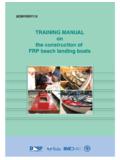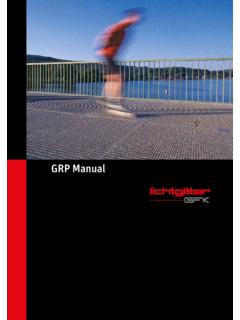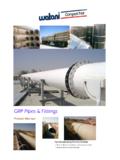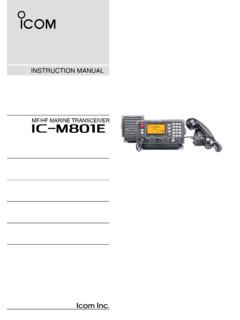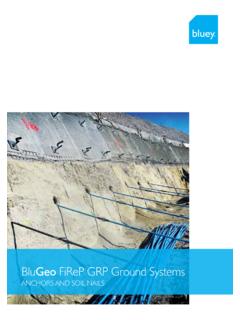Transcription of The C-Flex Manual - Seemann Composites
1 The C-Flex Manual FEATURES Preface Introduction Physical Properties Mechanical Properties Framing -Temporary Framework -Permanent and Temporary Framework -Traditional Wooden Framework Applying C-Flex Cutting the "Planks" Attaching the C-Flex to the Framework Saturating the C-Flex Laying up over the C-Flex Fairing the Hull Construction Examples 1 Appendix 1. Mechanical Properties- C-Flex Fiberglass Planking 2. Tools 3. Polyester Resins 4. Fiberglass Reinforcements 5. Hull Framing Systems 6. Deck Construction 7. Special Procedures-Use of Milled Fiber Paste 8. General Reference Sources for GRP Boat builders 2 PREFACE Because of the great adaptability of C-Flex , there are many different approaches to consider when determining a construction method for a C-Flex project.
2 In the development of C-Flex , Seemann Composites Inc. experimented with a broad range of construction techniques, many of which are practical for our uses, and some that could provide a good alternative for projects with a particular nature. The intention of this Manual is to give some insight into the different capabilities of C-Flex , while limiting it to a discussion of the basic approaches that are most suitable for a majority of boatbuilding projects and the fundamental information that can direct a builder through the fabrication of a C-Flex structure. Our objective is to reach the broadest possible spectrum of readers with this one book. We have included technical information for the experienced designer, as well as suggestions and outlines for the amateur.
3 We have done our best to provide sketches and photographs to illustrate the text, and we hope that both the professional and novice reader alike will find the information presented here clear and concise. This booklet is not intended to be a "complete boatbuilder s Manual ." There are countless sources that can be consulted for thorough and in depth information on working with fiberglass, lofting, building bases and framing interior finish, engine installation, etc. There is a brief recommendation of some sources that may be useful to any builder, found in the appendix. We must express our thanks to builders and designers who have worked with us closely and patiently to help us in our development of the C-Flex system. Our appreciation is directed towards many people, but we would especially like to single out Dave Sintes of Sintes Fiberglass in New Orleans, and Tom Dreyfus of New Orleans Marine, for their willingness to translate our ideas into practical applications in their construction shops.
4 A large part of the C-Flex building system evolved directly from Tommy's and Dave's efforts, and their contributions have certainly been instrumental in making C-Flex a viable construction medium. 3 INTRODUCTION There are obviously many advantages of glass reinforced plastics (GRP) that have made it such a vastly popular and lucrative construction medium. With GRP, strong and durable yet lightweight structures that require minimal maintenance can be fabricated. In addition, the versatility and accommodating nature of fiberglass reinforcements has made it possible to fabricate complex shapes out of GRP. However, the same traits that make fiberglass reinforcements so "workable", their softness and pliability, have made it necessary to use a full surface mold to shape the material in or over.
5 The need for a mold, while an advantage to a company producing many pieces from the same mold, makes it extremely difficult and expensive to fabricate "one-off" custom-built structures of GRP. After considerable research into custom building techniques, Seemann Composites Inc. has invented a fiberglass reinforcement, C-Flex Fiberglass Planking, that has had a radical impact on "one-off" fabrication. The C-Flex system is a unique development in glass reinforced plastic construction that may be utilized in a broad range of applications for the quick fabrication of low cost, low maintenance, custom-built structures. Among the many applications, C-Flex has been used to build storage tanks, automobile bodies, sculpture, and of course, boats of all sizes and types.
6 The use of C-Flex is widely varied but the procedure involved is basically the same in all building applications, so it is our intention to illustrate the general nature of the material and the distinct advantages of the system by outlining the process followed in boatbuilding. 4 PHYSICAL PROPERTIES C-Flex is a unidirectional fiberglass reinforcement that is manufactured in long (250' or more), 12" wide "planks" in two grades. The heavier grade, CF-65 (CF-21), is used for most applications including cruising boats of all sizes, fishing boats, industrial items, etc. The lighter grade, CF-39 (CF-13), was developed for lightweight racing boats, canoes, and other special applications where light weight is important. (Refer to Table 1). C-Flex contains rigid rods of pultruded GRP (much like fishing rods) on 1/2" centers which give it a self-supporting nature when spanning an open framework.
7 The rods have a very high glass/resin ratio, which means they impart high strength qualities to the structure in the direction which they run. The spacings between the rigid rods are filled with unsaturated strands of continuous fiberglass rovings, and when saturated, these also become excellent unidirectional reinforcements. A light fiberglass cloth holds the material together and gives C-Flex the ability to bias, which enables it to follow the exact contours of most surfaces and to conform to compound curved shapes, such as round bottom boat hulls. Since C-Flex retains a natural flexibility in all directions, no special tools such as heating ovens are needed to work with the material. TABLE I PHYSICAL PROPERTIES OF C-Flex CF-65 (CF-21) CF-39 (CF-13) WIDTH 12" ( ) 12" ( ) THICKNESS.
8 125" (318mm) .080" ( ) MAXIMUM RECOMMENDED SPAN 18" ( ) 14" ( ) WEIGHT (lbs/sq ft) .5" ( ) .33 ( ) RESIN REQUIRED (lbs/sq ft) .4" ( kg/m) .26 ( ) GLASS/RESIN RATIO 1/1 1/1 1/1 1/1 5 MECHANICAL PROPERTIES 1 Although C-Flex was originally developed as a simple method for building one-off boats, its strength properties as a unidirectional reinforcement have proven equally important. C-Flex has been tested by itself and also in combination with chopped strand mat and woven roving reinforcements, and the results of the tests have shown a high tensile strength and modulus for the C-Flex in the direction that the rods run (Warp2).
9 For this reason, when oriented fore and aft in a boat hull, C-Flex has been highly effective in increasing the longitudinal stiffness of sail and power boats. How this property of high tensile modulus can improve a structure is well illustrated by "Swampfire", the 1974 3/4 Ton World Cup Champion. With a total displacement of 9,250 pounds, "Swampfire" has approximately 5000 lbs. of lead in her keel, meaning a ballast/displacement ratio of In spite of her lightness, (some of her competitors at the 1974 World's competition weighed as much as 1000 lbs. more), the apparent stiffness of her hull was so impressive in the heavy swells of the Gulf Stream, that a comparative test to measure the fore and aft deflection was run between "Swampfire" and conventionally molded GRP 3/4 Ton competitors.
10 With "Swampfire", the amount of deflection was only 1/8", while on the more heavily constructed, molded hulls, the deflection was twice as much. Thus, C-Flex does effectively increase the overall longitudinal stiffness and strength of a hull, and this fact should be taken into account when designing scantlings and structural reinforcements for a boat to be built of C-Flex . 1 see Appendix 1, Mechanical Properties 2 see Appendix 1, Table 2 6 FRAMING C-Flex is used as a planking over a simple open framework, often very similar to the type used in traditional wooden boatbuilding. The framework should be constructed so that the material is supported by frames or lightweight battens running at approximate right angles to the rods.

